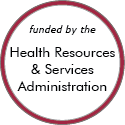Montana Models and Innovations
These stories feature model programs and successful rural projects that can serve as a source of ideas. Some of the projects or programs may no longer be active. Read about the criteria and evidence-base for programs included.
Effective Examples
Health Coaches for Hypertension Control

Updated/reviewed November 2025
- Need: A cost-effective approach to help rural patients with hypertension learn to manage their condition.
- Intervention: Community volunteers trained as health coaches provided an 8-session hypertension management training program to hypertension patients older than 60, with an optional supplemental 8 sessions focused on nutrition and physical activity.
- Results: Just 16 weeks after the program, participants had improved systolic blood pressure, weight, and fasting glucose, greater knowledge of hypertension, and improved self-reported behaviors.
New Mexico Mobile Screening Program for Miners


Updated/reviewed April 2025
- Need: To increase access to medical screening for miners in New Mexico.
- Intervention: A mobile screening clinic with telemedicine capability screens miners for respiratory and other conditions.
- Results: In a survey, 92% of miners reported their care as very good, while the other 8% reported it as good. The program has expanded to three other states.
Other Project Examples
One Health Recovery Doulas

Updated/reviewed November 2025
- Need: To support pregnant and parenting women with a history of substance use, mental health, or co-occurring disorders in rural areas of Montana.
- Intervention: One Health, a consortium of Federally Qualified Health Centers (FQHCs), developed a team of "recovery doulas" – individuals who are dual-certified as doulas and peer-support specialists. The One Health recovery doula program offers group and individual services to women and their partners from pregnancy through the first years of parenthood.
- Results: A team of four recovery doulas (or doulas-in-training) employed by One Health offer services in 8 rural eastern Montana counties. One Health has also successfully trained and certified 35 Peer Recovery Doulas statewide through their Peer Recovery Doula certification curriculum.
Montana Interfacility Blood Network (MT IBN)
Updated/reviewed July 2025
- Need: To provide blood transfusions in the ambulance on the way to a hospital.
- Intervention: The Montana Interfacility Blood Network includes 48 healthcare facilities that stock blood and allow ambulances to pick up units of blood while transporting a patient.
- Results: Since its launch, the network has helped at least three patients.
Together With Veterans Rural Suicide Prevention Program
Updated/reviewed July 2025
- Need: Suicide among veterans has been steadily increasing, and rural veterans have an increased risk of death by suicide compared to urban veterans.
- Intervention: A program called Together with Veterans was formed to help rural communities address and prevent suicides among veterans. The initiative is veteran-led, collaborative, evidence-based, and community-centered.
- Results: Data collection is ongoing.
Targeted Rural Underserved Track (TRUST) Program

Updated/reviewed April 2025
- Need: There is a shortage of rural physicians in the Northwestern United States.
- Intervention: University of Washington medical students are receiving training through the TRUST program in rural communities across a five-state radius.
- Results: Long-lasting connections have been formed among regional communities, medical students, and rural health professionals, with the goal of producing more rural physicians.
Rural Aging Action Network
Updated/reviewed January 2025
- Need: To connect isolated older adults and family caregivers in rural Minnesota, Montana, North Dakota, and South Dakota to services and supports so they can age in place.
- Intervention: The Rural Aging Action Network is a national collaborative of organizations that mobilize whole communities to address gaps in care for older adults and family caregivers.
- Results: Since 2022, the collaborative has reached over 600 older adults and over 100 family caregivers living in rural communities.
Butte Child Evaluation Center

Updated/reviewed August 2024
- Need: Before 2000, Butte and southwest Montana saw around 1,300 cases of child abuse a year, with only a 20% conviction rate for perpetrators of sexual abuse.
- Intervention: Multiple agencies in the community came together to address the issue of child abuse by forming the Butte Child Evaluation Center (CEC), a Children's Advocacy Center.
- Results: During a 3-year grant cycle, over 200 interviews and exams were performed on victims of sexual abuse and the Butte CEC became the first program in Montana to be accredited by the National Children's Alliance.
Bozeman Health RV Parking Program
Added February 2024
- Need: To provide a convenient and affordable lodging option for patients who have traveled from a distance to receive medical treatment in Bozeman, Montana.
- Intervention: An RV parking program that lets anyone who is actively seeking care at Bozeman Health Deaconess Regional Medical Center stay in the hospital parking lot.
- Results: Throughout the summer of 2023, at least one patient was using an RV parking space at all times.
Targeted Rural Health Education Project
Updated/reviewed January 2024
- Need: Dual platform to teach both plain language use and health literacy principles to health professions students and disseminate health information to rural populations.
- Intervention: Writing project using community-specific public health data in order to write a plain language health education article suitable for publication in a rural newspaper.
- Results: Since program start in 2017, over 60 students have successfully published their plain language health education articles in 17 rural newspapers in 3 states.
Last Reviewed: 12/11/2023

